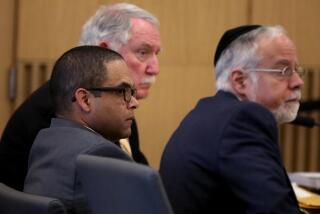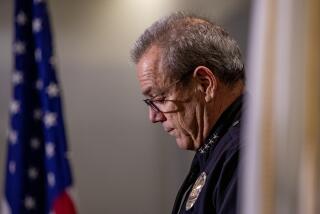Video in South Carolina police shooting makes building a defense that much harder
Unlike other videos in the last year that have shown a law officer shooting an unarmed suspect, the shaky smartphone footage that went viral this week leaves little to the imagination. And that, legal experts say, will leave attorneys for Michael T. Slager to build their defense on what happened before a passerby pushed the “on” button, capturing the 33-year-old North Charleston police officer firing eight times at the back of a fleeing man in South Carolina.
Shortly after the video emerged Tuesday, authorities charged Slager with murder. Although hundreds of fatal shootings involving law enforcement officers occur each year, few criminal charges are filed, and murder charges are rare.
Prosecuting such cases is typically an uphill battle because of how much leeway the law gives to officers in the line of duty. But veteran lawyers and legal experts say this video’s clear depiction of Slager shooting and killing Walter Scott will make the job of the officer’s attorneys much harder.
“You’ve got a very extreme case,” said Franklin Zimring, a UC Berkeley law professor who is writing a book on police shootings. “There are 500 killings by police in the U.S. each year. How many of them are realistic candidates for the criminal conviction of officers? They would be on the fingers of one hand.... This may very well be the one.”
Particularly damning for the officer is the legal standard under the 1985 U.S. Supreme Court decision Tennessee vs. Garner, which established that it is unconstitutional to use deadly force against a non-dangerous fleeing suspect only to prevent them from getting away.
Because the video appears to tell the story of the shooting so clearly, experts said defense attorneys for the officer would focus on the seconds before what the footage captures and the officer’s state of mind.
“What other things did the video not capture?” said defense attorney Michael Schwartz, who has successfully defended a Fullerton police officer charged with involuntary manslaughter and excessive force in the 2011 beating death of a mentally ill homeless man. Schwartz said the law deferred to officers’ judgment if they’re acting in self-defense or in the defense of others.
Defense attorneys, experts said, will probably emphasize that the interaction between Scott and Slager before the shooting is not seen, nor is the traffic stop that began the incident. This, they said, will leave room for argument on whether the officer may have felt threatened.
“What was the conversation and interaction between the officer and the subject?” said retired Los Angeles Police Capt. Greg Meyer. “Why did the subject run away?”
Ed Obayashi, an attorney and sheriff’s deputy in Northern California who is a use-of-force expert, said defense attorneys could also try to make an issue out of how quickly prosecutors decided to file murder charges.
“In the wake of Ferguson and other incidents, some may see this as a rush to judgment by the government,” he said, referring to the fatal shooting of an unarmed black man by a white police officer and the subsequent unrest in Ferguson, Mo., last summer.
Criminal convictions of officers in shootings are rare across the U.S. An Ohio professor who reviewed nationwide shooting cases between 2005 and 2011 found 28 instances of murder or non-negligent manslaughter charges filed against officers during the period, of which fewer than half resulted in convictions. In the same period, FBI statistics said there were more than 2,700 cases of “justifiable homicide” by law enforcement officers.
The State, a Columbia, S.C.-based newspaper, published an analysis last month reviewing 209 officer-involved shootings in the state over five years and found that none resulted in convictions of the officer. Only one case went to trial, but ended in a hung jury, the newspaper reported.
Experts say the South Carolina video may make this case different.
“On its face, the video causes great concerns about the use of deadly force in this case,” said Meyer, who appeared as a defense witness in the case of an Oakland transit officer charged with murder in the shooting of a suspect.
Obayashi said the video showed the entire shooting, leaving no doubt about the sequence of events.
“I see an officer and I see a suspect running and then getting shot in the back multiple times a good distance away,” he said.
Experts said the hardest part of what’s shown in the video for Slager’s attorneys to argue away before a jury would be the number of shots fired, and what appears to be evidence tampering by the officer after Scott is gunned down. Slager said in initial statements, and over the police radio, that Scott wrestled with him for his Taser; the video appears to show the officer dropping an object next to Scott’s prone body.
“Of particular concern is why the officer appears to move the Taser from one location to another after the shooting,” Meyer said.
Charles “Sid” Heal, a retired Los Angeles County sheriff’s commander, said there wasn’t much in the video to help the defense. “The man is basically running and never even turns to look. He isn’t zig-zagging, and he’s shot several times in the back.”
Heal said he was at a conference of law officers in the Seattle area this week and the video was the talk of the meeting. “No one here can really justify a circumstance for this shooting,” he said.
Others note, however, that video evidence has often failed to secure convictions of police officers in California.
Transit officer Johannes Meserle, charged in the New Year’s Eve shooting death of Oscar Grant in Oakland, was cleared of second-degree murder and voluntary manslaughter and convicted on a lesser charge of involuntary manslaughter.
Fullerton officers charged in the death of homeless man Kelly Thomas were acquitted. So were the officers seen on videotape beating Rodney King — touching off the 1992 L.A. riots.
“There’s always a rush to judgment,” said John Barnett, a defense attorney who worked on the King and Fullerton cases. “Video never tells the whole story.”
More to Read
Start your day right
Sign up for Essential California for news, features and recommendations from the L.A. Times and beyond in your inbox six days a week.
You may occasionally receive promotional content from the Los Angeles Times.








